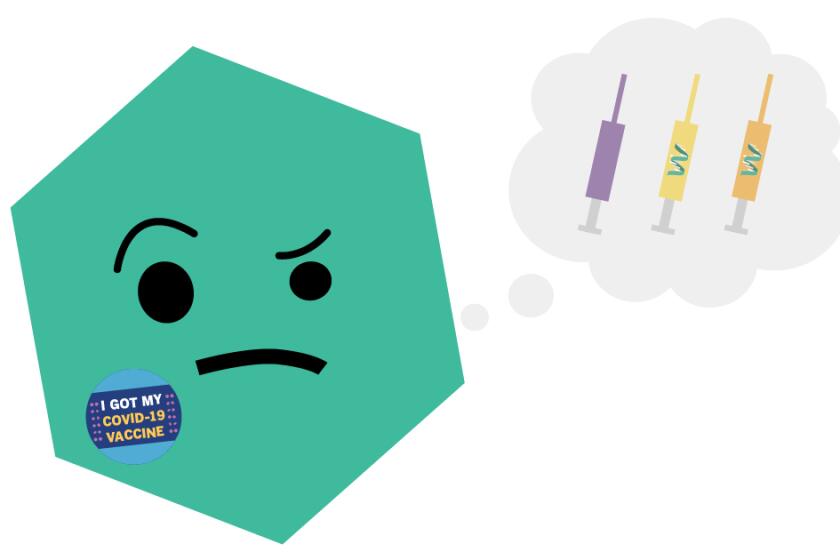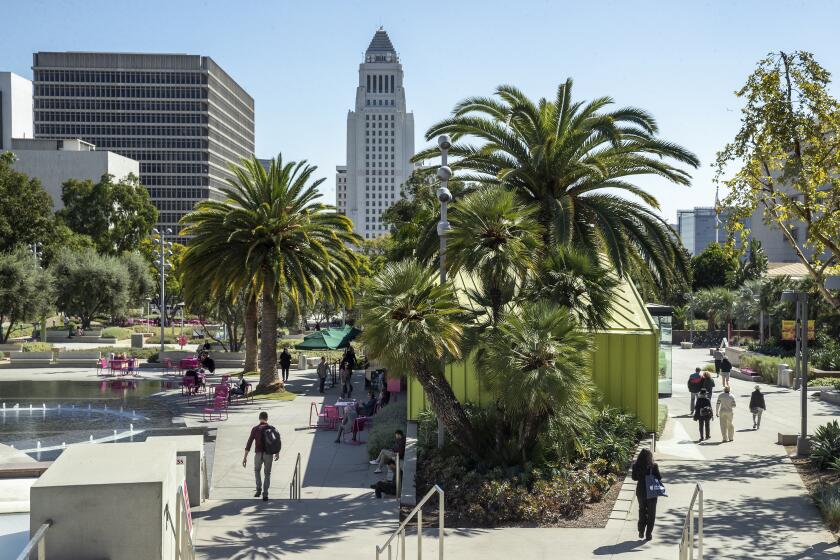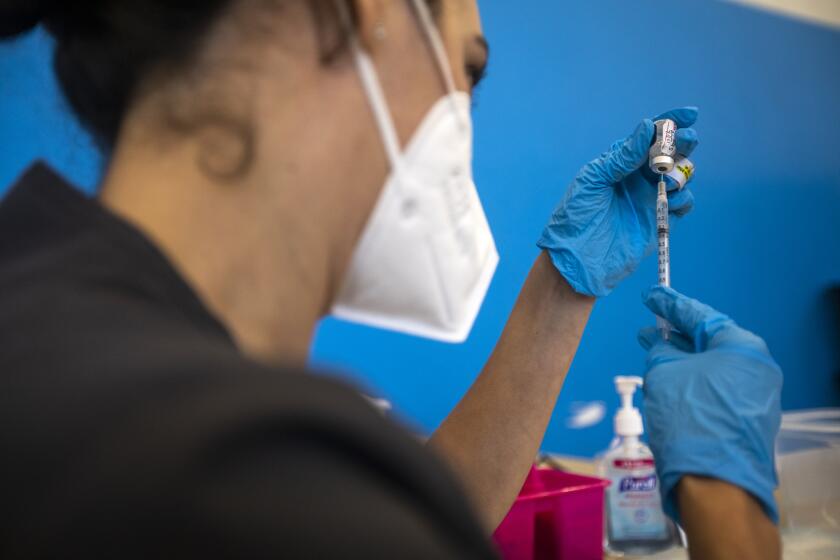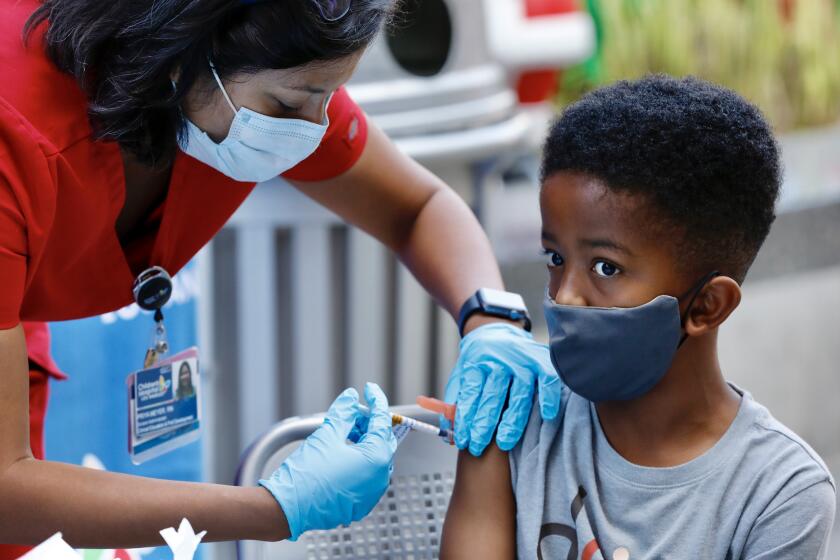COVID-19 hospitalizations rising in parts of California, a potentially ominous sign
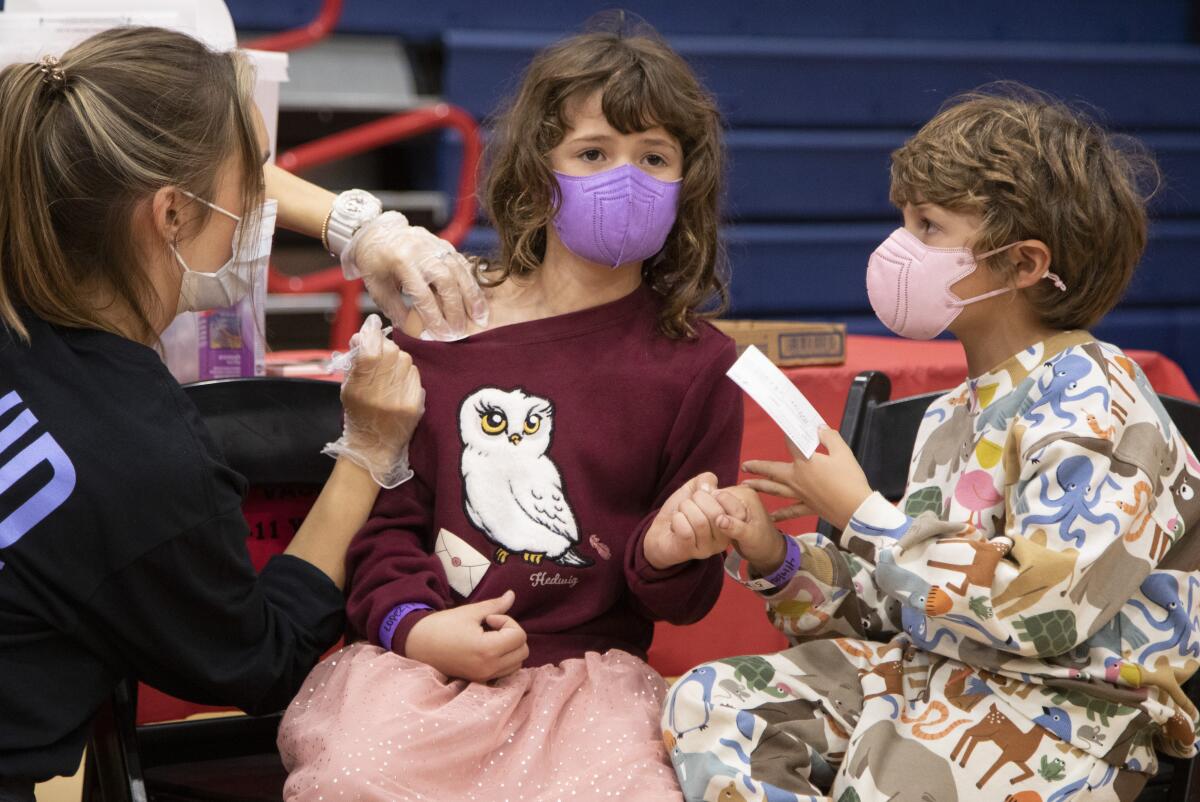
- Share via
COVID-19 hospitalizations have risen significantly in the Inland Empire and Central Valley, bringing new concerns about whether the shift represents a precursor to a wider spike in COVID-19 in California as the winter holidays approach.
Across the state, both cases and hospitalizations hit a plateau after months of decline. Hospitalizations have remained fairly flat in some areas with relatively high vaccination rates, including the San Francisco Bay Area and Los Angeles County.
But in some areas with lower vaccination rates, such as Riverside, San Bernardino and Fresno counties, conditions are deteriorating, with hospitalizations up by more than 20% in recent weeks. And even some places with relatively high vaccination rates are seeing COVID-19 hospitalizations tick upward; in Orange County, COVID-19 hospitalizations are up by 16% since Halloween.
Health officials have been warning about a potential new rise in COVID-19 in California as seniors who got their shots last winter — and haven’t received a booster shot — may start to see their immunity wane, leaving them exposed to greater risk for infection and hospitalization, and as people gather indoors more as the weather cools and the holidays approach.
Demand for booster shots has fallen below expectation in California. And each infected Californian is increasingly spreading the coronavirus to more people; as of Saturday, computer models estimated that every infected Californian was spreading the virus on average to 0.96 other people; if that number rises above 1, that will set the stage for further growth of the pandemic.
“COVID cases are beginning to rise. Winter months [mean] people indoors and more possibilities for spread,” Gov. Gavin Newsom tweeted Tuesday morning.
“Keep your immunity up,” he added. “Get your booster.”
Officials are hopeful that strict vaccination requirements in some of California’s most populated areas will help slow the spread of cases in the winter. In Los Angeles, a new city rule generally requiring patrons to show proof of full vaccination to enter venues like indoor restaurants, gyms, movie theaters, and hair and nail salons went into effect Monday, but won’t be enforced until after Thanksgiving.
Only weeks ago, officials in the San Joaquin Valley were optimistic that trends were headed in the right direction. But now, officials say hospitals in Fresno County, the most populous county in the region, “really have never left the crisis,” said Dan Lynch, director of the Central California Emergency Medical Services Agency.
“The bigger hospitals are probably between 110% to 130% of normal capacity. And they are all holding ICU patients, again, back in their emergency departments,” Lynch said. “We’re seeing the hospital emergency departments overwhelmed.”
Most hospitals have been forced to postpone scheduled surgeries, and some patients needing specialty care may need to be referred to other parts of California, officials said.
Many of the COVID-19 patients needing hospitalization are unvaccinated people in their 30s, 40s and 50s, said Fresno County interim health officer Dr. Rais Vohra. Fresno County on Wednesday was forced to reimplement a measure to no longer automatically transport all 911 patients to emergency rooms, a policy it had ended on Oct. 22 because officials thought the region’s surge of the Delta variant was fading.
“If you asked me two weeks ago what I thought would happen, I really thought that we were going to have a nice, relaxing November,” Vohra said. Now, “it’s been very humbling just because this pandemic keeps throwing us curveballs and this November plateau is really keeping us very busy.”
COVID-19 vaccine boosters are now available. But, they’re only recommended for some people. See if you are eligible here.
Of California’s five regions as defined by the state Department of Public Health, the San Joaquin Valley has the worst COVID-19 hospitalization rate, with 25 COVID-19 hospitalizations for every 100,000 residents; followed by rural Northern California, which has a rate of 16 and the Greater Sacramento area, with a rate of 14.
The statewide rate is 10, and the two most populous regions have rates below that: Southern California’s rate is 8, while the Bay Area’s is 4. Some experts believe it’s a sign of concern when COVID-19 hospitalization rates are 5 or greater for every 100,000 residents.
Within Southern California’s most populated areas, the Inland Empire has the worst COVID-19 hospitalization rates, with San Bernardino and Riverside counties reporting respective rates of 14 and 11. San Diego County is reporting 8; Orange County, 7; L.A. County, 6 and Ventura County, 4.
Since mid-October, COVID-19 hospitalizations have risen by more than 27% in both San Bernardino and Fresno counties; while in Riverside County, numbers are up by 21% over the last two weeks.
While health officials have largely been optimistic that the state’s relatively high level of vaccine coverage will keep conditions from deteriorating to the devastating extent seen last fall and winter, the turning of the calendar carries a host of additional risks.
Colder weather, even in normally balmy parts of California, will increasingly push people to gather indoors — where the risk of coronavirus transmission is higher. There’s also an apparent seasonality to the coronavirus itself, which makes it easier to spread when temperatures fall.
A packed slate of holidays will also entice people to travel and gather, possibly to an extent not seen since the pandemic began.
Add it all up, and you have a recipe for another potential coronavirus resurgence.
It’s already happening in other parts of the nation.
“Even in highly vaccinated places like New Hampshire and Vermont, you can see how these northernmost tiers of counties are starting to develop outbreaks and more transmission, as is Alaska,” Dr. George Rutherford, a UC San Francisco epidemiologist and infectious diseases expert, said recently at a campus forum.
The biggest concentration of coronavirus cases has expanded from Montana, Idaho, North Dakota and Wyoming, and is spreading farther south, through Colorado, Utah, New Mexico and Arizona.
States with both low vaccination rates, like Wyoming, where only 44.4% of residents are fully vaccinated, are seeing among the nation’s highest case rates, as are several states with vaccination rates similar to California’s 61.8%, such as Colorado (62.1%), New Mexico (62.5%) and Minnesota (61.6%), Rutherford said.
That’s why Colorado, New Mexico and Minnesota could be warning signs of California’s future, Rutherford said. Those three states have weekly coronavirus case rates that are triple what California is reporting now; Wyoming’s is more than 3½ times worse than California’s.
L.A. requires proof of COVID-19 vaccination to enter indoor restaurants, malls, theaters, salons, coffee shops, gyms, museums, performance venues and other spaces.
Rutherford said, relatively speaking, L.A., Orange and Ventura counties are doing well, but warned that San Diego, Riverside and San Bernardino counties have a fairly high level of cases.
These factors all suggest that it is urgent that unvaccinated people get their shots, including children age 5 to 11 who just became eligible last week, Rutherford said. People who have recovered from COVID-19 still need to get immunized, too; a study published by the U.S. Centers for Disease Control and Prevention said COVID-19 survivors who remained unvaccinated were five times more likely to get a new coronavirus infection compared with fully vaccinated people who had never been infected.
More evidence shows that vaccinations can offer better protection against COVID-19 than natural immunity from a prior infection.
And people who are immunocompromised or are seniors need to get additional vaccinations to improve their immunity, Rutherford said. The CDC says that less than 33% of fully vaccinated California seniors age 65 and over have received a booster dose, “which is a big problem that needs to be addressed,” Rutherford said.
That means there’s a race to get more seniors boosted before their immunity wanes too much, Rutherford said. A study published in the journal Science recently showed that all three COVID-19 vaccines available to Americans have lost some of their protective power, with vaccine efficacy among a large group of veterans dropping between 35% and 85%.
Some experts have already expressed hope that the worst of the pandemic is over and another surge is unlikely. Other experts, including Rutherford, are not so sure. While Rutherford said he expected that California “should be out of this by spring,” November will probably be decisive in giving us a clue in how the rest of the fall and winter will unfold.
“If we get out on the other side of it and have high levels of people vaccinated, a lot of vaccine coverage, then I think we might be able to really kind of throw the masks away, return to normal,” Rutherford said. “It’s not inconceivable that the Bay Area and urban Southern California could really walk away with high levels of vaccination — especially if we can get it into these younger kids — that will really create something that looks like herd immunity.”
Rutherford added: “If not, then we’re gonna have to string this out longer.”
Part of the pandemic’s future in California, too, will depend on getting more people around the world vaccinated, reducing the risk of an even more problematic variant emerging, Rutherford said.
L.A. County’s months-old mandate to wear masks in indoor public places will likely be in place through the end of the calendar year. Special state rules for so-called mega-events, which were initially set to expire this month, have instead been extended indefinitely.
“We’re worried about the winter, I’ll just be honest,” L.A. County Public Health Director Barbara Ferrer said during a recent briefing. “We don’t like what we’re seeing in Europe. We know there’s seasonality to this virus, we can’t escape that reality. We know that people go indoors more, even here in L.A. County, when the weather gets colder. And we know the holidays are coming.”
The next chapter of the push to boost COVID-19 vaccinations rates started Wednesday, as children ages 5 to 11 began rolling up their sleeves — a long-awaited new phase of the inoculation campaign.
According to a recent survey commissioned by the American Hotel and Lodging Assn., 29% of Americans said they were likely to travel for Thanksgiving — up from 21% last year. The share of people who said they were likely to do so for Christmas, 33%, was also up from last year’s 24%.
Of those surveyed, 58% said they were planning to vacation somewhere within driving distance on account of the pandemic.
Unlike last year, health officials aren’t directly recommending residents avoid traveling for the holidays. Instead, they’re reiterating the importance of taking precautions.
“This is where people, vaccinated or not, should really continue to practice the preventive measures we’ve been talking about from the beginning of this pandemic, which includes washing your hands frequently, wearing a mask, trying to keep your distance, being in well-ventilated areas,” said Dr. Regina Chinsio-Kwong, a deputy health officer for Orange County.
Times staff writer Melissa Healy contributed to this report.
More to Read
Sign up for Essential California
The most important California stories and recommendations in your inbox every morning.
You may occasionally receive promotional content from the Los Angeles Times.
